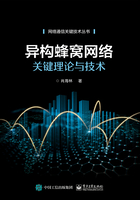
参考文献
[1]Cisco. Cisco Annual Internet Report (2018-2023)[OL]. Cisco Syst. Inc., San Jose, CA, USA, White Paper, Mar. 2020.
[2]CHUN J, HASNA M, GHRAYEB A. Modeling Heterogeneous Cellular Networks Interference Using Poisson Cluster Processes [J]. IEEE Journal on Selected Areas in Communications, 2015, 33(10): 2182-2195.
[3]CHEN Y, AI B, NIU Y, et al. Sub-Channel Allocation for Full-Duplex Access and Device-to-Device Links Underlaying Heterogeneous Cellular Networks Using Coalition Formation Games[J]. IEEE Transactions on Vehicular Technology, 2020, 69(9): 9736-9749.
[4]LÜ S, XING C, ZHANG Z, et al. Guard Zone Based Interference Management for D2D-Aided Underlaying Cellular Networks [J]. IEEE Transactions on Vehicular Technology, 2017, 66(99): 5466-5471.
[5]SUN J, ZHANG Z, XIAO H. Uplink interference coordination management with power control for D2D underlaying cellular networks: Modeling, algorithms, and analysis [J]. IEEE Transactions on Vehicular Technology, 2018, 67(9): 8582-8594.
[6]WEN K, CHEN Y, HU Y. A resource allocation method for D2D and small cellular users in HetNet [C]//2017 3rd IEEE International Conference on Computer and Communications (ICCC). IEEE, 2017: 1-5.
[7]AHMED I, ISMAIL M, HASSAN M. Video Transmission Using Device-to-Device Communications: A Survey [J]. IEEE Access, 2019, 7: 131019-131038.
[8]ZHANG H, LIAO Y, SONG L. D2D-U: Device-to-device communications in unlicensed bands for 5G system [J]. IEEE Transactions on Wireless Communications, 2017, 16(6): 3507-3519.
[9]LI Y, SHENG M, SHI Y. Energy efficiency and delay tradeoff for time-varying and interference-free wireless networks [J]. IEEE Transactions on Wireless Communications, 2014, 13(11): 5921-5931.
[10]LU B, LIN S, SHI J, et al. Resource Allocation for D2D Communications Underlaying Cellular Networks over Nakagami-m Fading Channel [J]. IEEE Access, 2019, 7: 21816-21825.
[11]SHAMAEI S, BAYAT S, HEMMATYAR A M A. Interference Management in D2D-Enabled Heterogeneous Cellular Networks Using Matching Theory [J]. IEEE Transactions on Mobile Computing, 2019, 18(9): 2091-2102.
[12]JIANG F, WANG B C, SUN C Y, et al. Resource allocation and dynamic power control for D2D communication underlaying uplink multi-cell networks [J]. Wireless Networks, 2018, 24(2): 549-563.
[13]DHILLON H, GANTI R, BACCELLI F, at al. Modeling and analysis of K-tier downlink heterogeneous cellular networks[J]. IEEE Journal on Selected Areas in Communications, 2012, 30(3): 550-560.
[14]HAENGGI M. Stochastic Geometry for Wireless Networks. Cambridge, U.K.:Cambridge University Press, 2012.
[15]MIN H, LEE J, PARK S, et al. Capacity enhancement using an interference limited area for device-to-device uplink underlaying cellular networks [J]. IEEE Transactions on Wireless Communications, 2011, 10(12): 3995-4000.
[16]RANDRIANANTENAINA I, ElSAWY H, DAHROUJ H. Uplink power control and ergodic rate characterization in FD cellular networks: A stochastic geometry approach [J]. IEEE Transactions on Wireless Communications, 2019, 18(4): 2093-2110.
[17]HUANG Y, NASIR A A, DURRANI S, et al. Mode Selection, Resource Allocation and Power Control for D2D-Enabled Two-Tier Cellular Network [J]. IEEE Transactions on Communications, 2016, 64(8): 3534-3547.
[18]ZHANG H, SONG L, HAN Z. Radio Resource Allocation for Device-to-Device Underlay Communication Using Hypergraph Theory [J]. IEEE Transactions on Wireless Communications, 2016, 15(7): 4852-4861.
[19]GRADSHTEĬN I S, RYZHIK I M, GERONIMUS Y V, et al. Table of integrals, series, and products[M]. Cambridge, MA, USA: Academic Press, 2007.
[20]OMRI A, HASNA M O. A distance-based mode selection scheme for D2D-enabled networks with mobility [J]. IEEE Transactions on Wireless Communications, 2018, 17(7): 4326-4340.
[21]LIU X, XIAO H, CHRONOPOULOS A T. Joint mode selection and power control for interference management in d2d-enabled heterogeneous cellular networks[J]. IEEE Transactions on Vehicular Technology, 2020, 69(9): 9707-9719.
[22]MIN H, LEE J, PARK S, et al. Capacity enhancement using an interference limited area for device-to-device uplink underlaying cellular networks [J]. IEEE Transactions on Wireless Communications, 2011, 10(12): 3995-4000.